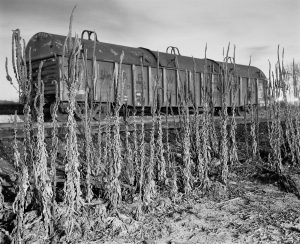Curators' Pick
Mimi Plumb | The Golden City, 1984 - 2020

Mimi Plumb | The Golden City, 1984 – 2020
So this is where the Renaissance has led to | And we will be the only ones to know
So take a drive and breathe the air of ashes | That is, if you need a place to go
If you have to beg or steal or borrow | Welcome to Los Angeles, City of Tomorrow
(Phil Ochs, The World Began In Eden And Ended In Los Angeles)
When I first encountered Plumb’s images, that song from the late Phil Ochs came to mind. It seems upbeat and pleasant but is, in fact, nuanced with a despair that is subtle but builds (and I will admit my interpretation may be coloured by his suicide. But the rendition of that song I am familiar with is a live version, and Ochs talks at the beginning of his fascination with Los Angeles “which intrigues me like a sensual morgue.” Plumb’s works have a certain sterility, to them, as well, that intersects with this consideration).
As with Plumb’s photographs, there’s more at play than the obvious. Considering that California exists in imaginations just as vividly – if not always accurately – as any seminal ‘place’ like ‘Siberia’, Plumb’s photographs invite us to construct narratives around them, that build, converge or perhaps complete what she intends, with her own personal stories….
I will admit that when looking at Mimi Plumb’s photography, that The Golden City often blended with another body of work of hers, titled The White Sky. I doubt that the artist would be offended by that, as the elements of memory, nostalgia and social realism suffuse her practice, and are themes that are present in her artwork still. Although her narrative is a personal one, it also has elements that are more universal, when considering larger tropes that her work touches upon.
“The Golden City [is] a series of images that frames subjects against the sprawling backdrop of San Francisco. Similar to Plumb’s other bodies of work, The Golden City is an ode to an earlier America—a rich and playful elaboration on the human condition, and its tendencies towards hedonism and spectacle. To say that this work largely references the exploitation of the natural world on account of humans would be reductive. While sculptural detritus and empty construction sites set the groundwork for this series, Plumb flips dramatic irony on its head by capturing subjects enthralled by events transpiring just beyond the frame. We are not in on the comings and goings within this world, but are sucked in nonetheless; left only with a sense of wonder at what could be bringing about such awe.” (from Document, with an engaging conversation with Plumb you can read as well)
Much more of Plumb’s work – from this series and a number of others – can be seen here. If you’d like to listen to her talk about her work, the Museum of Contemporary Photography has a video you can enjoy here.
Plumb published a book of selected images from this body of work with Stanley/Barker books in 2022.
~ Bart Gazzola


